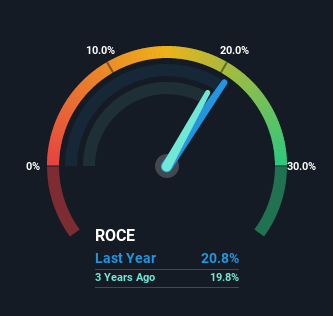- United States
- /
- Media
- /
- NasdaqCM:THRY
Thryv Holdings (NASDAQ:THRY) Is Investing Its Capital With Increasing Efficiency
If we want to find a potential multi-bagger, often there are underlying trends that can provide clues. Firstly, we'd want to identify a growing return on capital employed (ROCE) and then alongside that, an ever-increasing base of capital employed. This shows us that it's a compounding machine, able to continually reinvest its earnings back into the business and generate higher returns. So when we looked at the ROCE trend of Thryv Holdings (NASDAQ:THRY) we really liked what we saw.
Return On Capital Employed (ROCE): What is it?
Just to clarify if you're unsure, ROCE is a metric for evaluating how much pre-tax income (in percentage terms) a company earns on the capital invested in its business. The formula for this calculation on Thryv Holdings is:
Return on Capital Employed = Earnings Before Interest and Tax (EBIT) ÷ (Total Assets - Current Liabilities)
0.21 = US$213m ÷ (US$1.4b - US$343m) (Based on the trailing twelve months to March 2022).
So, Thryv Holdings has an ROCE of 21%. In absolute terms that's a great return and it's even better than the Media industry average of 7.1%.
See our latest analysis for Thryv Holdings

Above you can see how the current ROCE for Thryv Holdings compares to its prior returns on capital, but there's only so much you can tell from the past. If you'd like to see what analysts are forecasting going forward, you should check out our free report for Thryv Holdings.
What Does the ROCE Trend For Thryv Holdings Tell Us?
Shareholders will be relieved that Thryv Holdings has broken into profitability. While the business was unprofitable in the past, it's now turned things around and is earning 21% on its capital. Interestingly, the capital employed by the business has remained relatively flat, so these higher returns are either from prior investments paying off or increased efficiencies. That being said, while an increase in efficiency is no doubt appealing, it'd be helpful to know if the company does have any investment plans going forward. So if you're looking for high growth, you'll want to see a business's capital employed also increasing.
For the record though, there was a noticeable increase in the company's current liabilities over the period, so we would attribute some of the ROCE growth to that. Essentially the business now has suppliers or short-term creditors funding about 25% of its operations, which isn't ideal. Keep an eye out for future increases because when the ratio of current liabilities to total assets gets particularly high, this can introduce some new risks for the business.
The Key Takeaway
To bring it all together, Thryv Holdings has done well to increase the returns it's generating from its capital employed. Since the stock has returned a staggering 271% to shareholders over the last five years, it looks like investors are recognizing these changes. With that being said, we still think the promising fundamentals mean the company deserves some further due diligence.
If you want to know some of the risks facing Thryv Holdings we've found 3 warning signs (1 is a bit unpleasant!) that you should be aware of before investing here.
If you'd like to see other companies earning high returns, check out our free list of companies earning high returns with solid balance sheets here.
Valuation is complex, but we're here to simplify it.
Discover if Thryv Holdings might be undervalued or overvalued with our detailed analysis, featuring fair value estimates, potential risks, dividends, insider trades, and its financial condition.
Access Free AnalysisHave feedback on this article? Concerned about the content? Get in touch with us directly. Alternatively, email editorial-team (at) simplywallst.com.
This article by Simply Wall St is general in nature. We provide commentary based on historical data and analyst forecasts only using an unbiased methodology and our articles are not intended to be financial advice. It does not constitute a recommendation to buy or sell any stock, and does not take account of your objectives, or your financial situation. We aim to bring you long-term focused analysis driven by fundamental data. Note that our analysis may not factor in the latest price-sensitive company announcements or qualitative material. Simply Wall St has no position in any stocks mentioned.
About NasdaqCM:THRY
Thryv Holdings
Provides digital marketing solutions and cloud-based tools to the small-to-medium-sized businesses in the United States.
Good value with adequate balance sheet.
Similar Companies
Market Insights
Community Narratives




